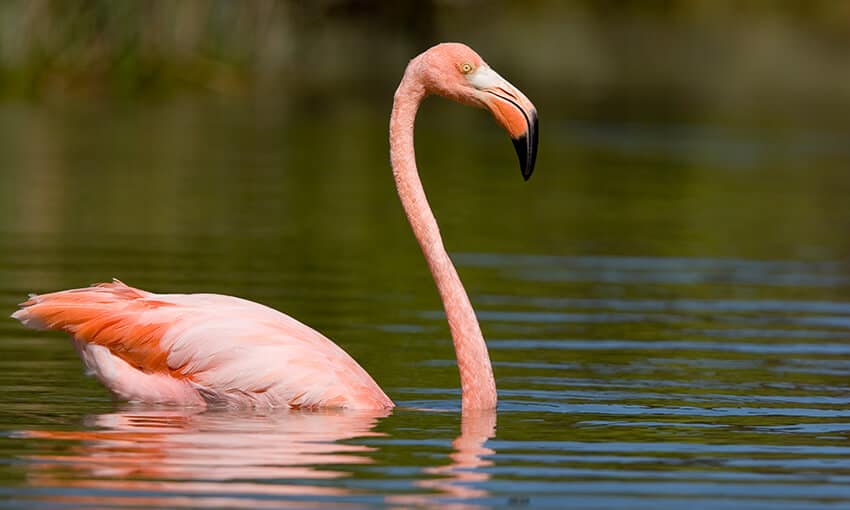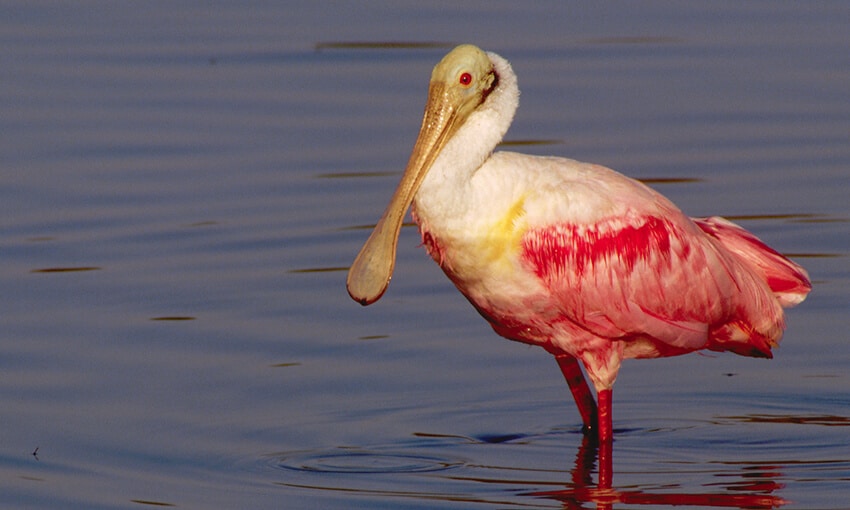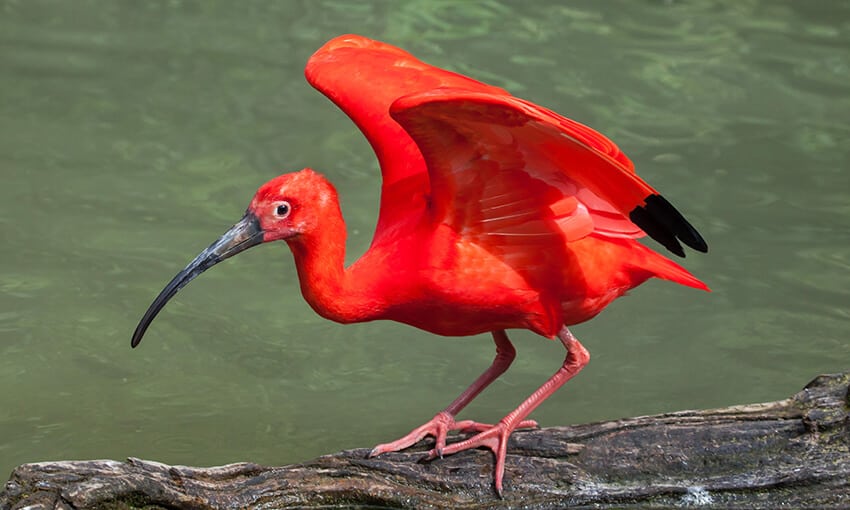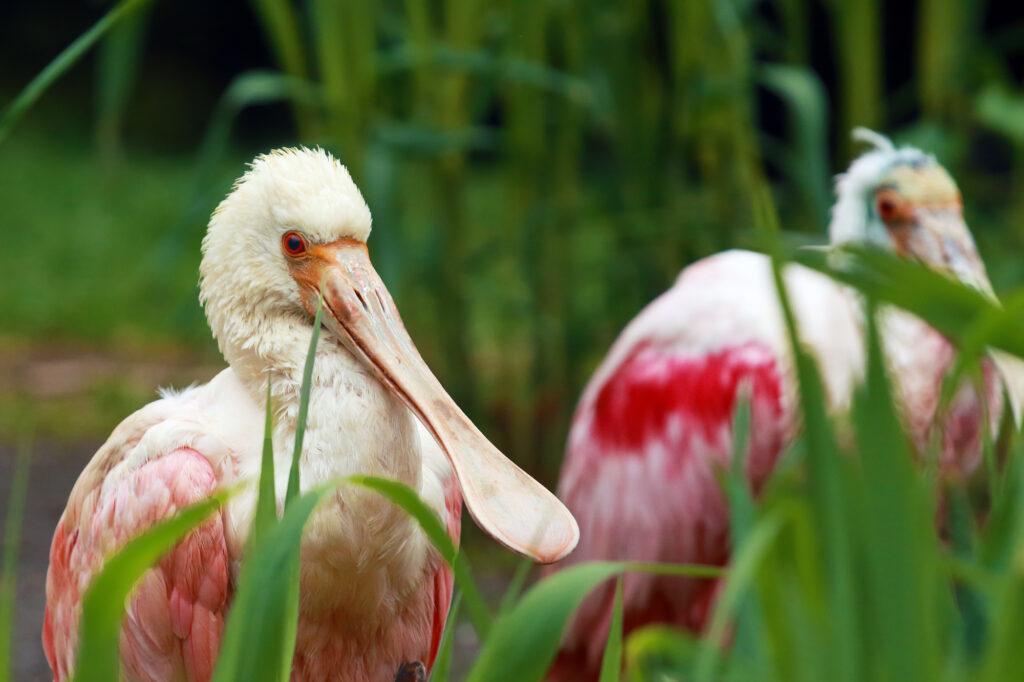Of the three large pink birds associated with Florida, only one is truly native to North America—the roseate spoonbill. The flamingo is a transplant from the Bahamas and the scarlet ibis is a rare vagrant from South America or an escapee from an aviary or zoo in North America.
All three birds are in good standing with the International Union for Conservation of Nature1, where their populations are listed as birds of “least concern” meaning they are not recognized as “threatened” or “near threatened.”
Pink Birds in Florida
1. American Flamingo (Phoenicopterus ruber)

There are six species of flamingo worldwide. But only one, the American flamingo, finds its way to Florida.
Description
Length (Height) 1.5 m (5 ft)
Wingspan – Up to 1.5 m (5 ft)
Weight 1.8-3.6 kilograms (4-8 lb.)
Longevity: 40-60 years2 (https://nationalzoo.si.edu/animals/american-flamingo)
Voice3
Range
Despite their association with Florida, the American Flamingo is native to the Bahamas, Aruba, and Cuba, and along the coasts of Caribbean islands and the adjacent coasts of Central and South America.
Best Places to See
The flamingo is considered a vagrant in Florida, where it may be seen in the Everglades and other areas where there are salt flats and shallow salt water in which to feed. In Florida and the rest of the United States, flamingos are commonly seen in parks, e.g., Busch Gardens or Disney properties, and zoos.
Additional Information
Flamingos feed by dipping their distinctive beak, with a 45-degree bend in the middle, into the water in search of algae, aquatic plants, worms, insect larvae, small mollusks and crustaceans4 and shrimp. It is the shrimp in their diet that gives them their rosy pink color.
Flamingos have a habit of standing on one leg for long periods of time: even sleeping standing on one leg. Theories on why the one-legged stance include: to keep one leg warm next to its body, too allow one leg to dry, or as visual defense behavior because on one leg they may look more like a plant to a predator.
Although the flamingo’s “knee” appears to bend backward (i.e., forward); what appears to be the knee is actually the ankle. Their short, 3-inch thigh is hidden under the feathers of the body, where the knee attaches.
Flamingos lay one egg in a nest of mud. Both adults share in tending the egg.
2. Roseate Spoonbill (Platalea ajaja)*

Of the three large pink birds associated with Florida, only the roseate spoonbill is a true native of the area.
Description
Length: 71–86 cm (28–34 in.)
Wingspan: 120–133 cm (47–52 in.)
Weight: 1.2–1.8 kg (2.6–4.0 lb.)
Longevity: 10-15 years
*Some authors place the spoonbill in its own genus, Ajaia.
Their signature feature is the spatulate (spoon-shaped) bill that it swings sided to side in the water as it walks. It feeds on crustaceans, aquatic insects, frogs, and small fish.
Unlike the flamingo, the roseate spoonbill is white on the neck and back down to the wings. The color intensity of the roseate spoonbill can vary significantly from bright magenta to a pale pink. Like the flamingo, the color is derived from their diet of shrimp and related creatures that provide the carotenoid pigment needed for coloration5.
Voice
The roseate spoonbill is a relatively quiet bird. It occasionally makes clicking sounds and a simple raspy call6.
It does have several sets of calls when in the colony7 and roosting.8 (htpps://nas-national-prod)
Range
The roseate spoonbill may be found in all Gulf coast states and as far north as South Carolina, as well as the Caribbean and in South America as far south as Chile. It frequents coastal marshes, lagoons, mudflats, and mangrove keys. Spoonbills forage in shallow water with a muddy bottom, in both salt and fresh water, including tidal ponds, coastal lagoons and inland marshes.
Best Places to See
The roseate spoonbill can be found along the Gulf Coast of the United States and Florida’s Atlantic coast, especially in the Merritt Island National Wildlife Refuge near the Kennedy Space Center. Another popular place to observe roseate spoonbills is the “Ding” Darling National Wildlife Refuge9 on Sanibel Island on Florida’s Gulf Coast.
Additional Information
Spoonbills have an established mating routine that begins with mutual aggressiveness, followed by perching together, offering each other sticks, and crossing or clasping bills. They nest during the winter in Florida, in mangroves and shrubs, or on the ground. Typically, there are two to five eggs per nest.10
Are Spoonbills in Danger of Extinction?
Spoonbills were common in the Unites states until the 1860s. They were hunted, nearly to extinction for their colorful plumage. Colonies began to return to Texas and Florida by the early 20th century. While the national population In the United States appears to be safe, local populations are at risk of loss of habitat and feeding grounds due to development. Overall, they are not in immediate danger of extinction and are classified by the IUCN as “of least concern.”
In Popular Culture
“In the James Bond novel (not the movie) Dr. No11, the roseate spoonbill is instrumental in the story, as the destruction of its nesting area (and killing of a pair of ornithologists that observed them) sets off the chain of events that brings the secret agent to the island, Crab Key. It is likely no coincidence that the real-life James Bond, the ornithologist, was an expert on Caribbean birds, having written the influential standard work ‘Birds of the West Indies.’”
The Flamingo and Spoonbill Compared
Both the flamingo and spoonbill are large wading birds that feed by capturing insects, small shrimp, crustaceans, and small fish with their specialized bills.
The flamingo, however, is nearly twice as tall as the spoonbill. Flamingos are essentially solid pink all over, except for black on their wingtips.
Not only visibly shorter than the flamingo, the spoonbill typically has is solid white on its neck and back, and its neck is much shorter than the flamingo’s.
The defining differences between the two are their bills. The flamingo has a “broken nose” appearance due to a 45-degree angle in the upper bill compared to the flat, spoon shaped bill of the spoonbill.
3. Scarlet Ibis (Eudocimus ruber)

The scarlet ibis is classified as a vagrant or accidental in the United States. It is not native to North America, however, imported birds were reared with the native white ibis, creating a pinkish hybrid. The scarlet ibis is common in zoos and parks such as Bush Gardens in Tampa.12, 13
Description
Length 55–63 cm (22–25 in.)
Wingspan: 54 cm (21 in.)
Weight: 1.4 kg (3.1 lb.)
Longevity: 16-20 years
The scarlet ibis (Eudocimus ruber formerly Guara ruber) inhabits tropical South America and the islands of the Caribbean. In form it resembles the white ibis in size and characteristics, except for its brilliant scarlet color, accented by black wing tips.
The American white ibis and the scarlet ibis are anatomically identical except for color, and they will interbreed. They are, however, regarded as distinct species.
Voice
The scarlet ibis’ voice is reported to be similar to the white (or glossy) ibis.14
Best Places to See
The scarlet ibis is rarely seen in the wild in the United States unless they have escaped captivity. Hybrid scarlet and white ibis, that escaped from a breeding program (1970s) were seen. The best places to see the scarlet ibis in the United States is in an aviary or zoo.
Range
The scarlet ibis is common throughout much of South America and the Caribbean. There have been rare sightings of the Scarlet Ibis in the United State—probably escaped or released captive birds.
_____
References
- International Union for Conservation of Nature: International Union for Conservation of Nature
- American Flamingo: Smithsonian’s National Zoo & Conservation Biology Institute: https://nationalzoo.si.edu/animals/american-flamingo
- YouTube: https://www.youtube.com/watch?v=iRj8sL41wbw
- Fresno Chaffee Zoo: https://www.fresnochaffeezoo.org/
- Roseate Spoonbill: https://en.wikipedia.org/wiki/Roseate_spoonbill
- Bird Sounds.net-Raspy Call: Roseate Spoonbill
- Roseate Spoonbill, NAS National Productions: Nesting
- Roseate Spoonbill, NAS National Productions: Roosting
- J. N. Darling National Wildlife Refuge, U.S. National Wildlife Refuge, Sanibel Island, Florida: Ding” Darling National Wildlife Refuge
- Roseate Spoonbill: https://en.wikipedia.org/wiki/Roseate_spoonbill
- Ian Fleming: Dr. No, Johnathan Cage Publisher, 1958
- Roger Tory Peterson: A Field Guide to the Birds East of the Rockies, Houghton Mifflin, 1980
- Scarlet Ibis: https://en.wikipedia.org/wiki/The_Scarlet_Ibis
- Glossy (White) Ibis: Macauly Library, Cornell Lab of Ornithology Voice

